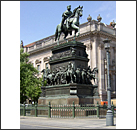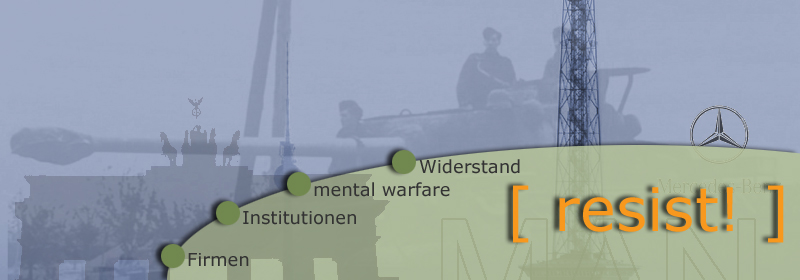Prussia
![]() Print
Print 
![]() Prussia
Prussia

Statue of the mounted Prussian King Frederick II, Prussian militarism
Behind us we see a statue of King Frederick II on horseback.
It was unveiled in 1851. The statue has several levels.
Dedications and names are inscribed on the base.
The second level includes sculptured horsemen and standing figures, who are famous contemporaries of Frederick II.
The theme of the third level focuses on the so-called cardinal virtues such as strength, justice, wisdom and temperance, which are represented by figures and relief scenes from the life
of the king.
After the dissolution of Prussia in 1947, it was discussed whether or not the statue should be dismantled. In 1950, it was moved to Sanssouci Park on the orders of the magistracy. A thaw in the Cold War in the 1970s led to its return to its original position on Unter den Linden in 1980.
Why was it so important for the Allies to dissolve Prussia, as ordered in February 1947 by the Allied Control Council? Prussia represented militarism. Frederick I, who was also known as the "Soldier King" and was the father of this horseman, molded every state body and class to the needs of the military. The military became the force that forged society and defined social and economic order. In the court hierarchy, the highest ranking officers had the highest status. About a quarter of all Berlin inhabitants at the time served the military. In the 18th Century, the Prussian army gained the reputation of being the "best army in the world." It was described as a "formidable war machine." But who paid the price for such superlatives?

In the Prussian military, Prince Leopold of Anhalt-Dessau introduced the forward march and the infamous drill. The simple soldiers were generally conscripted farmers' sons.
During battle deployment, large numbers of soldiers became canon fodder, while thousands died of typhoid due to malnutrition.
Long serving soldiers that were no longer fit to fight were happy if the king granted them permission to beg. Prussian soldiers deserted whenever they had the chance.
During battle, the officers stood with their pistols drawn behind the soldiers to shoot anyone attempting to desert.
Due to the high level of fleeing soldiers, the Prussian military could not be deployed at night or in difficult terrain, in contrast to their French opponents in the war of 1792.
 The extremely violent conscription of soldiers, mostly young farmers' sons from the provinces, who were literally kidnapped, began even earlier, at the end of the Thirty Years War in 1648.
When Frederick II died, the French statesman Count Mirabeau is reported to have said: "Other states have an army. Prussia is an army that owns a state."
The extremely violent conscription of soldiers, mostly young farmers' sons from the provinces, who were literally kidnapped, began even earlier, at the end of the Thirty Years War in 1648.
When Frederick II died, the French statesman Count Mirabeau is reported to have said: "Other states have an army. Prussia is an army that owns a state."
The militarisation of society ultimately led to a mental militarisation. It culminated in a widespread reverence for uniforms and a great enthusiasm for war on the eve of World War I. With their "Day of Potsdam" in 1933, the Nazis made a connection between the old and the new, the Second and the Third Reich. As a result of the burning of the Reichstag, the constituent assembly of the new government under Hitler could not convene in the Berlin Reichstag. Goebbels staged a highly symbolic meeting in the old garrison church in Potsdam, the traditional centre of Prussia. There, the continuity between the old Prussian traditions and the new National Socialism was highlighted.
summary: Preussen

